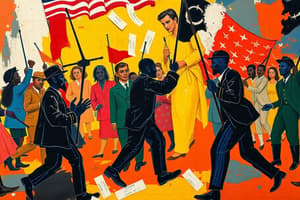Podcast
Questions and Answers
What was a primary economic difference between the North and the South that contributed to tensions leading up to the Civil War?
What was a primary economic difference between the North and the South that contributed to tensions leading up to the Civil War?
- The North had a strong dependence on cotton exports.
- The South's economy was reliant on slave labor for cotton production. (correct)
- The South relied on industrial manufacturing.
- The North focused on agricultural production.
Which battle is considered a turning point in the Civil War due to its significant Union victory?
Which battle is considered a turning point in the Civil War due to its significant Union victory?
- Battle of Antietam
- Battle of Vicksburg
- Battle of Fort Sumter
- Battle of Gettysburg (correct)
What was one of the outcomes of Lincoln's Emancipation Proclamation in 1863?
What was one of the outcomes of Lincoln's Emancipation Proclamation in 1863?
- It immediately abolished slavery in all states.
- It granted full citizenship rights to African Americans.
- It aimed to weaken the Confederacy by freeing slaves in rebel states. (correct)
- It was rejected by the Southern states.
Which Reconstruction policy aimed for stricter terms for Southern states to rejoin the Union?
Which Reconstruction policy aimed for stricter terms for Southern states to rejoin the Union?
Which amendment to the U.S. Constitution abolished slavery?
Which amendment to the U.S. Constitution abolished slavery?
What was a significant social change for African Americans during the Reconstruction era?
What was a significant social change for African Americans during the Reconstruction era?
What was the Freedmen's Bureau established to do?
What was the Freedmen's Bureau established to do?
Flashcards are hidden until you start studying
Study Notes
Causes Of The Civil War
- Slavery: Primary catalyst, causing conflict over its expansion into newly acquired territories, dividing North and South.
- States’ Rights: Southern states asserted their right to self-govern and create their own laws, fostering dissent.
- Economic Differences: Industrial North’s manufacturing economy clashed with the Agrarian South’s reliance on agriculture, particularly cotton, creating tension.
- Political Conflict: Struggles over congressional power balance intensified, particularly with the rise of the Republican Party opposing the expansion of slavery.
- Cultural Divides: Distinct identities and social norms developed in North versus South, contributing to increased animosity.
- Secession: Following Abraham Lincoln's election in 1860, several Southern states seceded, fearing the threat of slavery's abolition.
Key Battles And Strategies
- Fort Sumter (1861): Marked the Civil War's initiation when Confederate forces attacked this Union-held fort.
- Battle of Antietam (1862): The deadliest single-day battle in American history; its outcome led Lincoln to release the Emancipation Proclamation.
- Battle of Gettysburg (1863): Considered the war's turning point; Union victory halted Confederate General Robert E. Lee's advance into Northern territory.
- Sherman's March to the Sea (1864): A Union campaign that employed total war tactics to devastate Southern infrastructure and morale.
- Union Strategy: The Anaconda Plan aimed to suffocate the South economically through blockades and control of the Mississippi River.
Role Of Slavery
- Moral and Ethical Issues: Seen as a fundamental moral wrong by abolitionists, elevating the issue into a national debate and increasing sectional conflict.
- Economic Dependency: Southern states’ economies heavily depended on enslaved labor, especially in cotton cultivation, fueling resistance to abolition.
- Emancipation Proclamation (1863): Lincoln's directive aimed to disable the Confederacy by declaring freedom for slaves in rebellious states.
- African American Soldiers: Approximately 180,000 African Americans served in the Union Army, playing a crucial role in the Union's military efforts.
Reconstruction Policies
- Presidential Reconstruction: Favorable approach by Lincoln and Johnson, proposing lenient conditions for Southern states’ reintegration into the Union.
- Radical Reconstruction: Congress implemented stricter policies, exemplified by the Reconstruction Acts of 1867, addressing civil rights and governance.
- 13th, 14th, and 15th Amendments: This trio abolished slavery, granted citizenship and equal protection under the law, and secured voting rights for African American men.
- Freedmen's Bureau: Established to provide support for freed slaves, focusing on education, healthcare access, and employment opportunities.
Impact On African American Rights
- Short-term Gains: African Americans experienced increased political involvement, including holding office and exercising voting rights during Reconstruction.
- Social Changes: The creation of schools and churches fostered community growth and empowerment among African Americans, aiding their transition post-abolition.
Studying That Suits You
Use AI to generate personalized quizzes and flashcards to suit your learning preferences.




